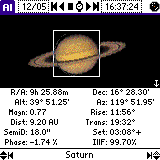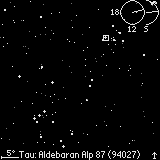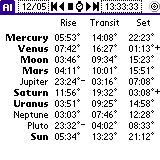Implementation Secrets
Prev: Toggle Night Mode Top: Main Page
If you wonder about the accuracy of Astro Info or the reasons why it is so fast even on your old Palm Vx, you find the answers here.

Accuracy
For computation of the planet and moon ephemeris, AstroInfo uses some standard algorithms.
- The planet ephemeris are from: J. Simon et al.:
Precession formulae and mean elements for the Moon and the planets . Astronomy & Astrophysics 282, 663-683 (1994). - The Moon ephemeris is based on: J. Meeus:
Astronomical Algorithms ,2nd Ed. - The basic for Nutation Theory is (IAU 2000b).
The displayed coordinates should be accurate to a few arcseconds in most cases.
The coordinates of the moon are always topocentric, i.e. as they appear from your current location. However, since AstroInfo does not ask for the height of your location this is not very exact at the moment. For all other planets the geocentric coordinates are given. The coordinates of the stars are heliocentric and the movement of the stars is not taken into account. However, AstroInfo consideres precession and nutation of the earth axis.


Star Map
The stars in the catalogue are organized in a tree sorted by their positions. Stars with smaller magnitude are stored deeper in the tree. For small zoom levels, only the node near to the root have to be read that contain the stars with large magnitude. For large zoom levels, most of the branches are cut-off, because they are outside the viewing area.
To compute the drawing position of a star, a single rotation is necessary. This is done with a fast matrix multiplication. The matrix can be computed once before drawing all stars.
The position of the planets have to be updated whenever the time is changed. However, the computation is fast enough to recompute everything for the few existing planets.


Mathematical Library
AstroInfo comes with its own fixed point library, which allows for fast computations of the thousands of operations it has to perform. Fixed point numbers are numbers, where the place of the decimal point is fixed. They are much faster than floating point numbers which have to take a floating decimal point into account. The only drawback is that one has to be careful with the magnitude of the numbers to prevent over- and underflows. The accuracy of these numbers is in the middle between single and double precision floats.
The fixed point library is assembler optimized and comes with the standard mathematical operation (the four basic operations, sine, cosine, arctan, logarithm and exponentiation). It should be easy to incorporate it in another Palm based project; ask me if you're interested in using them.

Prev: Toggle Night Mode Top: Main Page
Last updated on Sun May 13, 2007. Copyright 2001-2007, The AstroInfo SourceForge Project. All trademarks on this page are trademarks of their respective owners. These web pages were created with htp.